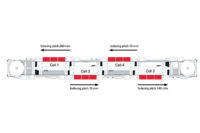Efficient bonding, sealing and potting has a major influence on the sustainable function and safety of electronic components. The key to success here lies in the comprehensive view and control of process engineering. Here it pays to seek collaboration with the systems and the material manufacturer during the very early stages of the project. This is because dispensing systems must be selected for compatibility with the workpiece and the adhesive, sealant or potting compound used. And there are also other factors that play an important role in designing the optimum dispensing system:
Task
At the beginning of a project, the task is documented in detail. Whether that is to seal, encapsulate, fill, insulate or dissipate heat has a major influence on the choice of the adhesive or potting material and thus also on the subsequent process engineering. Three main influencing factors must always be considered in this context: Air bubbles, moisture and the pot life of the materials used.
Workpiece design
Several central factors of process engineering depend on workpiece design. Increasingly smaller components and more complex geometries, spaces to be filled, undercuts, etc. determine, for example, whether atmospheric or vacuum processes should be used.
Material and material properties
The number of adhesives, sealants and potting materials is growing steadily. Whether epoxy, polyurethane, silicone or other materials – they all have advantages and limitations. Factors such as viscosity and filler content, but also curing and pre-treatment necessities must be considered. There are many processes nowadays which must be integrated into a comprehensive process engineering concept, both in terms of system and process technology.
Material feeding
Viscosity, filler content and type, as well as respective container size represent relevant basic information determining the feeding technology used. It is important here to avoid the introduction of air, to feed the medium gently and consistently throughout the entire process and to empty the selected containers as completely as possible.
Homogenizing
Only a homogeneous medium provides the necessary performance. Fillers are added to many materials to achieve specific properties. However, depending on the density or viscosity of the material, these fillers tend to sediment. Temperature also has an influence on the sedimentation process. To avoid sedimentation and to ensure constant material quality during the dispensing process, a suitable preparation system with integrated stirring and circulation mechanisms is recommended.
Degassing
Depending on the application requirements, air bubbles in the adhesive, sealing or potting material can lead to problems. If they reach the dispensing unit, they may falsify the dispensed quantity and the mixing ratio. This results in irregular production performance and even rejects. However, various technical solutions enable the minimization of the formation of air bubbles. For a bubble-free material, preparation under vacuum is the optimum solution.
Atmospheric or vacuum dispensing?
Atmospheric dispensing is standard nowadays and enough for many applications, but considering ever-smaller workpieces, increasingly complex geometries and higher quality requirements, vacuum potting systems are used more and more.
Dispensing method
Precision and repeatability are crucial factors for dispensing processes. Consequently, the decision for the right dispensing process under consideration of all general conditions is decisive for dispensing quality. For processes with the highest quality requirements, volumetric dispensing systems like piston and gear pump dispensers have established themselves.
Mixing
If a 2C material is selected, the next step is deciding on a mixing method. In static mixing, the two components are brought together and mixed in a plastic tube containing several mixing helixes, each rotated by 90°. Due to the simple process and low maintenance requirements, static mixing is an efficient and cost-effective solution. Dynamic mixing involves feeding the two components into a chamber with a given mixing ratio, where they are mixed by a rotating agitator.
Application
To achieve the desired dispensing result, the type of material application is essential. Here it is important to tailor the application unit individually to the corresponding requirements and to adjust the complete system to fit the dispensing task in terms of process technology.
Process and quality control
High quality requirements are standard for many sealed, encapsulated and bonded components today. In order to ensure consistently high-quality dispensing results, numerous options for process and quality control are available. For example, state-of-the-art sensors integrated into the dispensing system enable simple and reliable monitoring of the entire process.
Integration into production line
Dispensing systems rarely work stand-alone. They are integrated into increasingly complex production processes. This means interconnecting several dispensing systems, but also connecting them to upstream and downstream process steps, such as surface pre-treatment or curing. This is where it pays off to be able to access a system consisting of standard modules. The desired processes can be selected and combined to fit the requirements. This not only enables individual system planning, but also ensures attractive pricing and short delivery times.
Let`s talk about your requirements!




